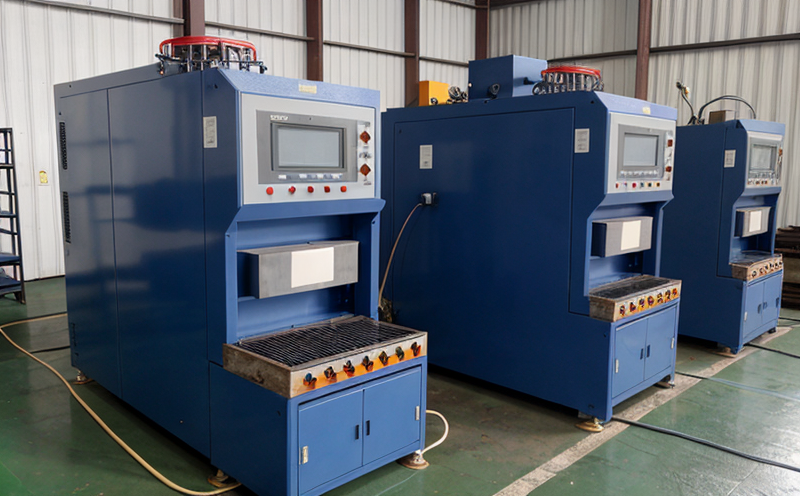ASTM E1086 Optical Emission Spectrometry for Aluminum Alloys Testing
ASTM E1086 Optical Emission Spectrometry (OES) is a critical analytical technique used in the industrial manufacturing and processing sector to ensure the quality and compliance of aluminum alloys. This method provides accurate and precise elemental analysis, allowing manufacturers to meet stringent industry standards and regulatory requirements. The application of ASTM E1086 is particularly important for sectors such as aerospace, automotive, and electronics, where the integrity and performance of materials are paramount.
The testing process involves the use of an OES instrument that excites sample atoms through a high-intensity light source. This excitation causes electrons to jump to higher energy levels temporarily before falling back to their ground state. The emitted light is then analyzed by the spectrometer, which separates it into its component wavelengths, allowing for the identification and quantification of various elements present in the alloy.
The elemental composition of aluminum alloys is crucial because even small variations can lead to significant changes in mechanical properties such as strength, ductility, and weldability. By conducting ASTM E1086 testing early in the production process, manufacturers can identify any deviations from specified compositions and make necessary adjustments before proceeding further.
The accuracy and reliability of ASTM E1086 are ensured through rigorous adherence to ISO standards, which provide guidelines on sample preparation, instrument calibration, and data interpretation. This ensures that results are consistent across different laboratories and over time.
In summary, ASTM E1086 Optical Emission Spectrometry is a cornerstone of quality assurance in the industrial manufacturing sector. It enables precise control over raw material specifications, ensuring compliance with international standards and enhancing product performance and reliability.
Why It Matters
The importance of ASTM E1086 Optical Emission Spectrometry cannot be overstated in the context of industrial manufacturing. Ensuring that aluminum alloys meet their intended specifications is critical for several reasons:
- Product Performance: The mechanical properties of aluminum alloys are heavily influenced by their elemental composition. Variations can lead to reduced strength, increased brittleness, or even failure under stress.
- Regulatory Compliance: Many industries must adhere to strict regulations regarding the quality and purity of materials used in their products. ASTM E1086 provides a standardized method for assessing compliance with these requirements.
- Economic Efficiency: Ensuring that raw materials meet specifications reduces the risk of costly rework or scrap, thereby improving overall production efficiency.
In conclusion, ASTM E1086 is essential for maintaining product quality and ensuring that manufacturers are meeting both internal and external expectations. By leveraging this testing method, companies can enhance their reputation for reliability and innovation in the market.
Scope and Methodology
The scope of ASTM E1086 Optical Emission Spectrometry is broad but focused on specific elements that are critical to aluminum alloys. The method covers a range of elements including, but not limited to, silicon (Si), manganese (Mn), copper (Cu), magnesium (Mg), and iron (Fe). These elements play key roles in determining the alloy's performance characteristics.
The methodology involves several steps:
- Sample Preparation: The sample must be carefully prepared according to ASTM E1086 guidelines. This includes cleaning the surface of the sample and ensuring it is representative of the bulk material.
- Spectrographic Analysis: Once prepared, the sample is placed in a crucible or on an electrode holder. A high-intensity light source excites the atoms within the sample, causing them to emit characteristic wavelengths of light.
- Data Collection and Interpretation: The emitted light is collected by a spectrometer and separated into its component wavelengths. This data is then analyzed to determine the concentration of each element present in the alloy.
The results from ASTM E1086 testing provide detailed information about the elemental composition of aluminum alloys, which is vital for ensuring that these materials meet specified requirements.
Quality and Reliability Assurance
- Consistency: Through rigorous adherence to ISO standards, ASTM E1086 ensures consistent results across different testing environments. This consistency is crucial for maintaining quality control processes.
- Data Accuracy: The precision of the OES instrument and the meticulous calibration process ensure that the data collected is accurate and reliable. This accuracy is vital for making informed decisions regarding material specifications.
- Rigorous Calibration: Before each test, the OES instrument undergoes a thorough calibration process to ensure that it operates within specified tolerances. This prevents any inaccuracies in the results due to instrumental errors.
- Data Validation: To further enhance reliability, data from ASTM E1086 testing is cross-validated using additional analytical techniques such as X-ray fluorescence (XRF) or inductively coupled plasma optical emission spectrometry (ICP-OES). This ensures that the results are robust and consistent.
The combination of these quality assurance practices ensures that ASTM E1086 testing is a reliable tool for manufacturers to ensure the quality and reliability of their aluminum alloys.





